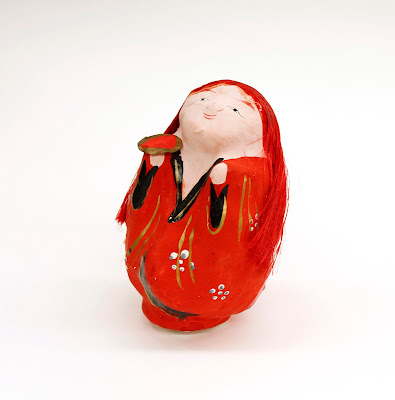 |
|
Hoko-san "Good Luck" Doll, 20th Century
Japanese; Takamatsu City, Shikoku Island, Japan
Papier maché, paint and synthetic hair; 5 1/2 × 3 × 3 in.
87.4.42a
Gift of the Clarence and Evanda Perry Trust
|
Good luck charms are used in a variety of cultures to ward off evil spirits and diseases. These talismans can take many forms: rings, pendants, human and animal figures. Despite this they always offer insight into their maker’s history and their own origin often tends to be shrouded in a mythology as rich as the good fortune they bring. As part of a larger Japanese tradition of charm dolls, the Hoko-san “Good Luck” Doll is no exception to bringing good to this world, but rather than being a bulwark against misfortune the Hoko-san doll absorbs disease from sick children, hailing back to its legendary antecedent, Omaki-san.
Hundreds of years ago a samurai’s beautiful daughter was dying of an incurable disease. Omaki, the daughter’s handmaid or hoko, from which the modern name Hoko-san evolved, dutifully stole her young lady’s disease. However, in doing so she condemned herself to die of the inevitable sickness. To ensure that she could infect no one else, Omaki sailed far away and passed on into story. Omaki’s sacrifice and miraculous healing of the noble’s daughter began the tradition of the hariko(papier-mâché) Hoko-San doll. Just as Omaki cured the samurai’s daughter, these Hoko-san dolls are believed to cure diseases by taking them from sick children. These papier mâché dolls of Hoko-san are put into the arms of a sick child for protection, and some customs still have the parents set the doll to float away down streams the morning after protecting a sick child.
 |
|
This seven-tiered display of dolls traditionally
arranged for Hinamatsuri is full of complicated
historical relevance, but imitates the Japanese
imperial court.
|
Though the tradition originated from feudal times when prevailing intra-familial relationships were vastly different from those in Japanese society today, Hoko-san dolls have always allowed people to express their selflessness. Especially in a society where grand displays of affection have been frowned upon, by giving the doll to their children parents have been able to subtly show their love for those they care most about. Now in Japan, March 3rdmarks the annual doll festival, Hinamatsuri. Doubling as Girls’ Day, this festival brings wellbeing and happiness to families’ daughters and is another chance to give dolls like Hoko-san to remove evil spirits.
The Bowers Museum’s Hoko-san “Good Luck” Doll is made using hariko craft similar to the traditional techniques revived in the 20th Century by prolific doll-maker Fusa Miyauji (1883-1985). Hoko-san is dressed in a painted red kimono with curious red synthetic hair. Most often, depictions of Omaki show her to have painted black hair, so it is uncertain why exactly this change of hair color is made. It could be as simple as a desire to use more red which is a Japanese symbol of good luck. Alternatively, it could be the evolution of the figure herself. If the latter is the case this evolution is certainly also evident in her changing role in Japanese society. As a far cry from Hoko-san’s original purpose of being given to cure disease, our Hoko-san was given as a memento to the couple who donated the doll to the Bowers Museum by the manager of an inn on a small island south of Kobe, Japan. Our Hoko-San doll’s arms are still extended in open embrace, happily welcoming any evils one might need to share the burden of fighting.
Text and images may be under copyright. Please contact Collection Department for permission to use. Information subject to change upon further research.



Comments 2
Interesting. Thanks for sharing.
Hello, would it be correct to say that Hoko-San dolls protect sick children and Hoko dolls protect expectant mothers?
Thank you.